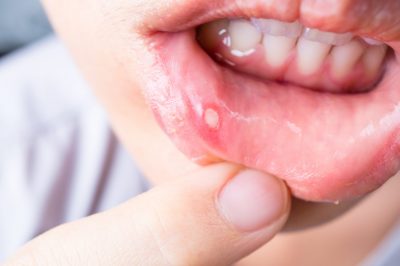Conditions That Are Strikingly Similar To Canker Sores!
 Nearly everyone gets canker sores from time to time. These small lesions are usually harmless and don’t pose any danger. However, if your canker sore fails to improve after a few weeks, it’s often recommended that you visit your healthcare provider to ensure it isn’t something to worry about.
Nearly everyone gets canker sores from time to time. These small lesions are usually harmless and don’t pose any danger. However, if your canker sore fails to improve after a few weeks, it’s often recommended that you visit your healthcare provider to ensure it isn’t something to worry about.
But what are they?
These are small lesions that can occur on either your gumline or on the soft palate inside your mouth. These small lesions usually measure less than a millimeter in diameter. In terms of appearance, they can be white, or yellowish featuring a red border.
No one knows the primary cause or causes of canker sores, but we know for sure that they aren’t contagious and can’t also be transmitted via saliva. They can be triggered by an injury, such as when you unknowingly bite your cheek, but they generally seem to appear out of nowhere.
They can be the result of many things, like a compromised immune system, stress, medication, dehydration, or even allergies.
Bearing in mind that there are other numerous conditions that look strikingly similar to canker sores, you shouldn’t make any false assumption that every sore around your oral region is a canker sore! Today in this post, we take a closer look at common conditions that can easily be mistaken for a canker sore.
Leukoplakia:
Leukoplakia is lesions that usually produce white patches or spots inside your mouth, and this is perhaps why you can easily mistake them for canker sores. However, as opposed to canker sores, these patches are neither painful nor sensitive.
And while they are not harmful like their canker sore counterparts, certain leukoplakia patches can be cancerous. Research tends to show that between 3 and 17.5% of individuals who suffer leukoplakia ultimately skin cancer! This implies that if you currently experience leukoplakia, your healthcare professional will likely conduct a biopsy to remove cancer from the picture.
Erythroplakia:
Most canker sores usually diminish within two weeks. So, if your symptoms fail to subside after this timespan, enlarges, or you are concerned about a certain sore, it’s high time you go for a medical evaluation.
Simply put,a sore that refuses to go away could be Erythroplakia, a type of lesion characterized by either reddish or whitish spots inside your mouth. However, it’s worth noting that these spots can be cancerous and this is why it’s highly recommended that you consult your doctor if you suspect you may be having Erythroplakia.
Even though the root cause of this condition remains a mystery, it has been associated with tobacco use and smoking!
Gingivostomatitis:
This is an infection of the gums and mouth that can result in lots of pain and only occurs after coming into contact with the HSV-1 the same herpes virus behind cold sores. This condition can attack virtually anyone, but is fairly more prevalent in children aged 5 and below. Studies suggest that nearly 90% of individuals come into contact with the virus before the age of fifty. However, not each one of them will experience cold sores after having an encounter with the virus.
Like its canker sore counterpart, this condition can result in red or white lesions inside of your cheek, or on the guns. However, unlike canker sore, Gingivostomatitis can result in halitosis, bleeding gums as well as fever. These sores are not permanent and will disappear within 14-21 days without any treatment. Using an antiviral drug such as Zovirax can potentially reduce the duration of your sores if administered within 3 to 4 days.
Oral cancer:
It’s important to mention that what looks like cancer could potentially turn out to be oral cancer. So, should you suspect that your sore is cancerous, don’t hesitate to consult your doctor. Mouth cancer can equally result in miniature ulcerations in your mouth. These lesions are not only very painful but also tend to get thicker with time. Early diagnosis and detection of oral cancer is key to preventing any type of cancer from advancing to the other parts of your system, including your lymph nodes.
It is imperative to note that whereas canker sores often occur on the soft palate in your oral region, mouth cancer can develop on your hard palate as well as your tongue. A mouth sore can be cancerous if you display other symptoms, including fever, throat hoarseness, or numbness, or if you are an ardent smoker or a fan of tobacco. Your doctor can conduct a biopsy to help eliminate out cancer. And if in any case, the test reveals that you have cancer, your healthcare provider will scan the area to gauge whether cancer has found its way to other parts of your body.
Lichen Planus:
If you happen to develop an itchy, tender white lesion, the chances are high that you may be suffering from lichen planus but not canker sore. The lesions may sometimes feature a lacelike patch on the inner parts of your cheeks. What’s unique about lichen planus is that it doesn’t just affect the inner parts of your mouth. Rather, it can affect some parts of your skin as well. And when this occurs, you’ll likely see itchy spots or bumps on your skin. This condition is usually triggered by an abnormal immune function, whereby your immune system attacks skin cells as well as the mucous membranes.
Oral thrush:
Equally known as oral candidiasis, oral thrush is simply a fungal infection characterized by white patches inside your mouth. Oral thrush is not only very painful, but can also be accompanied by a burning sensation, loss of taste, difficulty swallowing, and bleeding gums.
The conditions happen when yeast reproduces fairly fast in your mouth, usually due to a compromised immune system. Those who have been prescribed antibiotics or are currently taking a drug that suppresses their immune system as highly likely to experience oral thrush.
Cold sores:
Popularly described as fever blisters, these are simply painful blisters that are strikingly similar to canker sores in terms of characteristics. However, canker sores are somehow different in that they are triggered by the herpes simplex virus. As a result, they not only don’t occur on your keratinized tissues of the oral region but are equally not contagious.
Some individuals contract fever blisters after coming into close contact with the virus either via kissing or after sharing food or a drink with an already infected individual. Cold sores may be unpleasant, but they usually disappear after 2 or 3 weeks. However, sores may reappear!
The bottom line:
A sore inside your oral region is highly likely to be a canker sore, which is not only harmless but likely to disappear within a week or two. However, if your canker sore is unusually bigger, lasts more than two weeks, is painful, extends to your lips, results in fever, or makes it difficult for you to either eat or drink, don’t hesitate to seek immediate medical advice from your dentist or dermatologist.
If you are looking for a dentist, HPS Advanced Dental Care would love to see you. Dr. Heather is gladly accepting new patients.
We are located at 4741 24 Mile Rd. Shelby Township, MI 48316, and we can be reached at (248) 652-0024. We look forward to meeting you!





